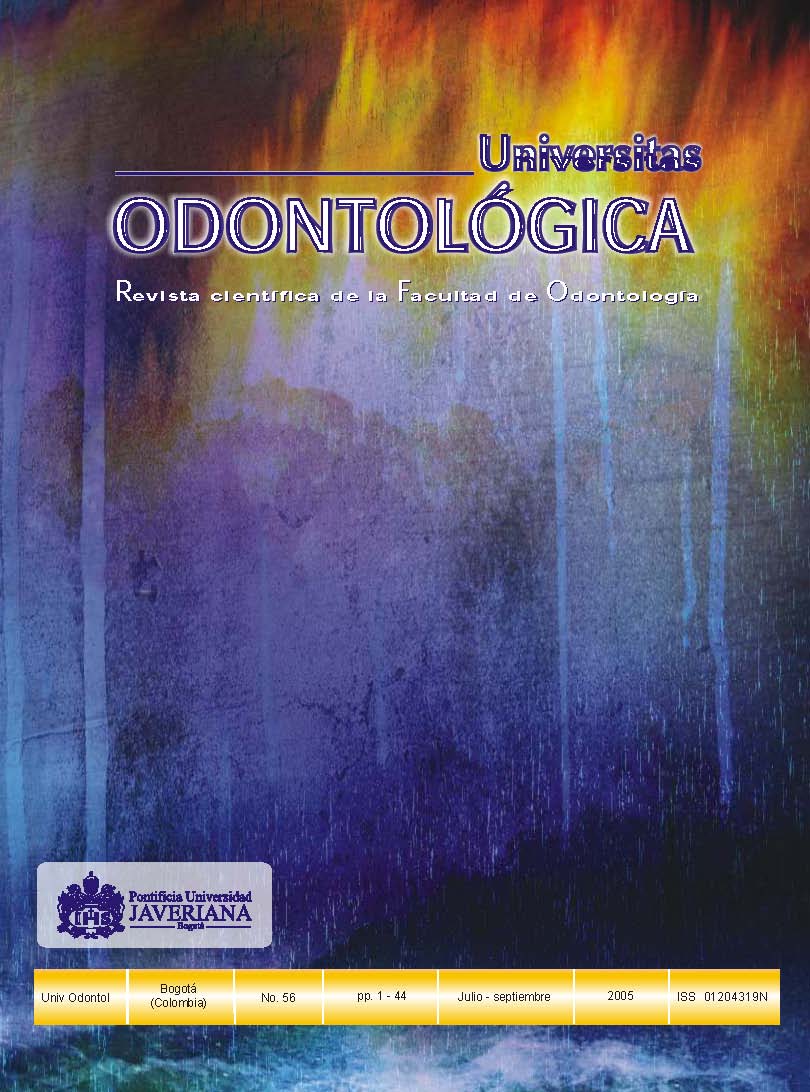Abstract
ANTECEDENTES: el Nitinol superelástico ha sido la aleación de elección utilizada en los alambres de uso ortodóntico en la primera fase del tratamiento. A pesar de sus óptimas cualidades, ese alambre es de uso limitado, por su alto costo, lo cual ha conllevado a que los ortodoncistas se vean motivados a reciclarlo con el fin de compensar su costo en la práctica clínica. OBJETIVO: reconocer las alteraciones de las propiedades mecánicas, de rigidez y superelasticidad de los alambres níquel titanio reutilizados y así regular ésta práctica en la clínica. METODOS: tipo de diseño experimental donde se utilizaron 56 alambres de Nitinol 0.016" 3M Unitek que fueron distribuídos aleatoriamente en grupos de esterilización (glutaraldehído y calor seco). Inicialmente se evaluó la rigidez en su condición original (T0) por medio de la prueba flexión y tensión y posteriormente fueron sometidos a cuatro ciclos de reciclaje. El análisis de los resultados fué fué realizado con la prueba t de Bonferroni (P>0.005)y el ANOVA de dos vías (p>0.05).RESULTADOS:durante la esterilización con frío se observó una tendencia al aumento del valor de rigidez , mientras lo contrario fué evidente al esterilizar con calor seco. La superelasticidad mostró en ambos grupos de esterilización una tendencia al aumento hasta T3. CONCLUSIONES: clínicamente no hay efectos significativos de la esterilización sobre los alambres.
BACKGROUND:Nitinol superelastic wires have been the primary allegiance used in orthodontic wires during the fist phase of treatment. Despite its qualities, these wires are of limited use because of it´s high cost, which has motivated orthondontic professionals to sterilize the material with the purpose of reducing the cost of daily practice. OBJECTIVE: recognize the alterations of the biochemical properties of stiffness and super elasticity of reused nickel-titanium wires and therefore regulate this practice in the clinical enviroment.
Andreasen GF, Morrow RE. Laboratory and clinical analyses of nitinol wire. Am J Orthod 1978; 73: 142-51.
López I, Goldberg J, Burstone CJ. Bending characteristics of nitinol wires. Am J Orthod 1979; 75(5): 569-75.
Drake S, Wayne D, Powers J, Asgar K. Mechanical properties of orthodontic wires in tension, bending, an torsion. Am JOrthod Sept 1982; 3: 206-10.
Kapila S, Sachdeva R. Mechanical properties and clinical applications of orthodontic wires. Am J Orthod Dentofac Orthop 1989; 96: 100-9.
Buckthal JE, Mayhew MJ, Kusy RP, Crawford JJ. Survey of sterilization and disinfection procedures. J Clin Orthod 1986; 20: 759-65.
Buckthall JE, Kusy RP. Effects of cold disinfectants on the mechanical properties and surface topography ofnickeltitanium arch wires. Am J Orthod Dentofac-Orthop 1988;94: 117-22.
Mayhew MJ, Kusy RP. Effect of sterilization on the mechanical properties and surface topography of nickel-titanium arch wires. Am J Orthod Dentofac-Orthop 1988; 93(3): 232-6.
Kapila S, Reichhold G, Anderson S, Watanabe L. Effects of clinical recycling on mechanical properties of nickeltitanium alloy wires. Am J Orthod Dentofac-Orthop 1991;100: 428-35.
Kapila S, Haugen J, Watabe L. Load-deflection characteristics of niquel-titanium alloy wire after clinical recycling and dry heat sterilization. Am J Orthod Dentofac Orthop 1992; 102:120-6.
Miura F, Mogi M, Okamoto Y. New application of superelastic NiTi rectangular wire. J Clin Orthod 1990; 24:544-8.
Waters NE. Superelastic nickel-titanium wires. Br J Orthod 1992; 19: 319-22.
Crawford JJ. State of the art: practical infection control in dentistry. J Am Dent Assoc 1985; 110: 629-33.
Sánches Y, Quiceno L, Aceveco MM. Manual de asepsia y bioseguridad de odontología. Departamento de Recursos Humanos del Instituto de Seguros Sociales, 1995.
Segner D, Ibe D. Superelastic materials displaying different force levels within one archwire. J Orofac Orthop 1998;59: 29-38.
Meling T; Odegaard J. The effect of temperature in the elastic responses to longitudinal torsion of rectangular nickel titanium arch wires. Angel orthodontist 1998; 4: 357-68.
Miura F, Mogi M, Ohura Y, Hamanaka H. The super-elastic properties of the Japanese NiTi alloy wire of use in orthodontics. AJODO 1986; 90: 1-10.
Staggers JA, Margeson D. The effects of sterilization on the tensile strength of orthodontic wires. Angle Orthod 1993;2: 141-4.
Smith G, Fraunhofer VY, Cassey G. The effects of clinical sterilization on selected orthodontic arch wires, AJODO 1992; 102: 153-9.
Tonner RI, Waters NE. The characteristics of superelastic Ni-Ti wires in tree - point bending. Part I: The effect of temperature. Eur J Orthod 1994; 16: 409-19.
Segner D, Ibe D. Properties of superelastic wires and their relevancy to orthodontic treatment. Eur J Orthod 1995; 17:395-402.
This journal is registered under a Creative Commons Attribution 4.0 International Public License. Thus, this work may be reproduced, distributed, and publicly shared in digital format, as long as the names of the authors and Pontificia Universidad Javeriana are acknowledged. Others are allowed to quote, adapt, transform, auto-archive, republish, and create based on this material, for any purpose (even commercial ones), provided the authorship is duly acknowledged, a link to the original work is provided, and it is specified if changes have been made. Pontificia Universidad Javeriana does not hold the rights of published works and the authors are solely responsible for the contents of their works; they keep the moral, intellectual, privacy, and publicity rights.
Approving the intervention of the work (review, copy-editing, translation, layout) and the following outreach, are granted through an use license and not through an assignment of rights. This means the journal and Pontificia Universidad Javeriana cannot be held responsible for any ethical malpractice by the authors. As a consequence of the protection granted by the use license, the journal is not required to publish recantations or modify information already published, unless the errata stems from the editorial management process. Publishing contents in this journal does not generate royalties for contributors.


